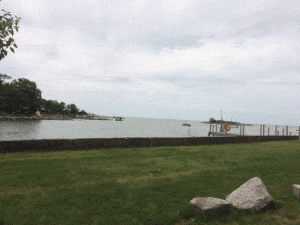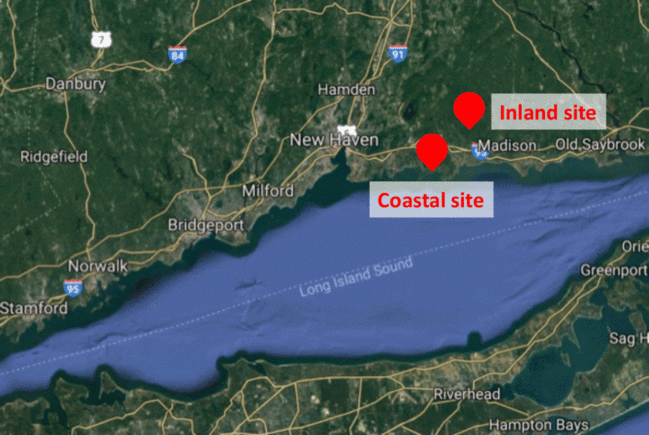Last summer, we set up an air quality monitoring station at the Yale Coastal Field Station in Guilford, CT. It is well established that much of Connecticut suffers from poor air quality due to transport of air pollution from New York City (and other seaboard states south of NYC). This results from the transport of reactive organic chemicals emitted south of Connecticut that chemically transform as air masses blow up along the coast. This includes primary pollutants emitted directly from sources (e.g. carbon monoxide, black carbon, sulfur dioxide, from any source that burns fuel, like cars or power plants). More importantly, it includes secondary pollutants, formed following chemical transformations of gas-phase organic compounds in the atmosphere: principally ozone and secondary organic aerosol (SOA)—colloquially known as photochemical smog. Ozone and SOA both have multifaceted health effects on cardiovascular, pulmonary, and cognitive function. Many of these pollutants also have important impacts on the environment, including the earth’s climate.
In our trailer, we are measuring several pollutants, some of which are regulated by the U.S. EPA due to their detrimental effects on human health and the environment, including:
- Ozone*
- Carbon dioxide
- Carbon monoxide*
- Sulfur dioxide*
- Nitrogen oxides*
- Black carbon
- PM2.5.* (particulate matter with a diameter less than 2.5 microns)
- Gas and particle-phase organic compounds
- We are also measuring temperature, relative humidity, wind speed, and wind direction with the weather station you see on the mast outside the trailer
*= National Ambient Air Quality Standards set by the U.S. EPA (https://www.epa.gov/criteria-air-pollutants/naaqs-table)
 We aim to track these changes in the concentrations of these primary and secondary pollutants, to better understand where they come from, what they are are made of (particularly for low concentration gas-phase and particle-phase organic compounds), and how they may impact human health and/or our environment.
We aim to track these changes in the concentrations of these primary and secondary pollutants, to better understand where they come from, what they are are made of (particularly for low concentration gas-phase and particle-phase organic compounds), and how they may impact human health and/or our environment.
This study represents a collaborative effort between Yale’s School of Engineering & Applied Science, The Peabody Museum, and the School of Forestry & Environmental Studies.


